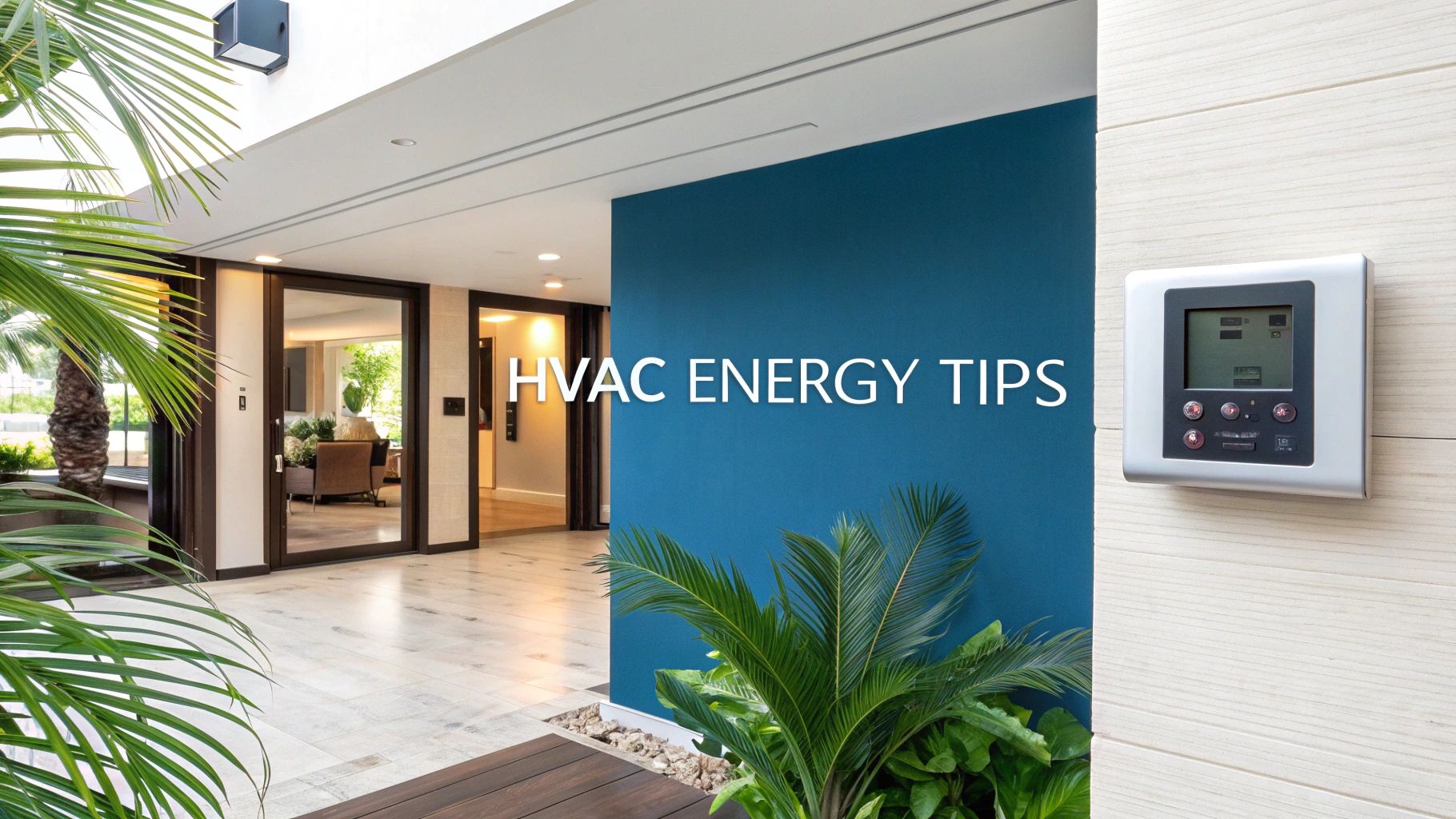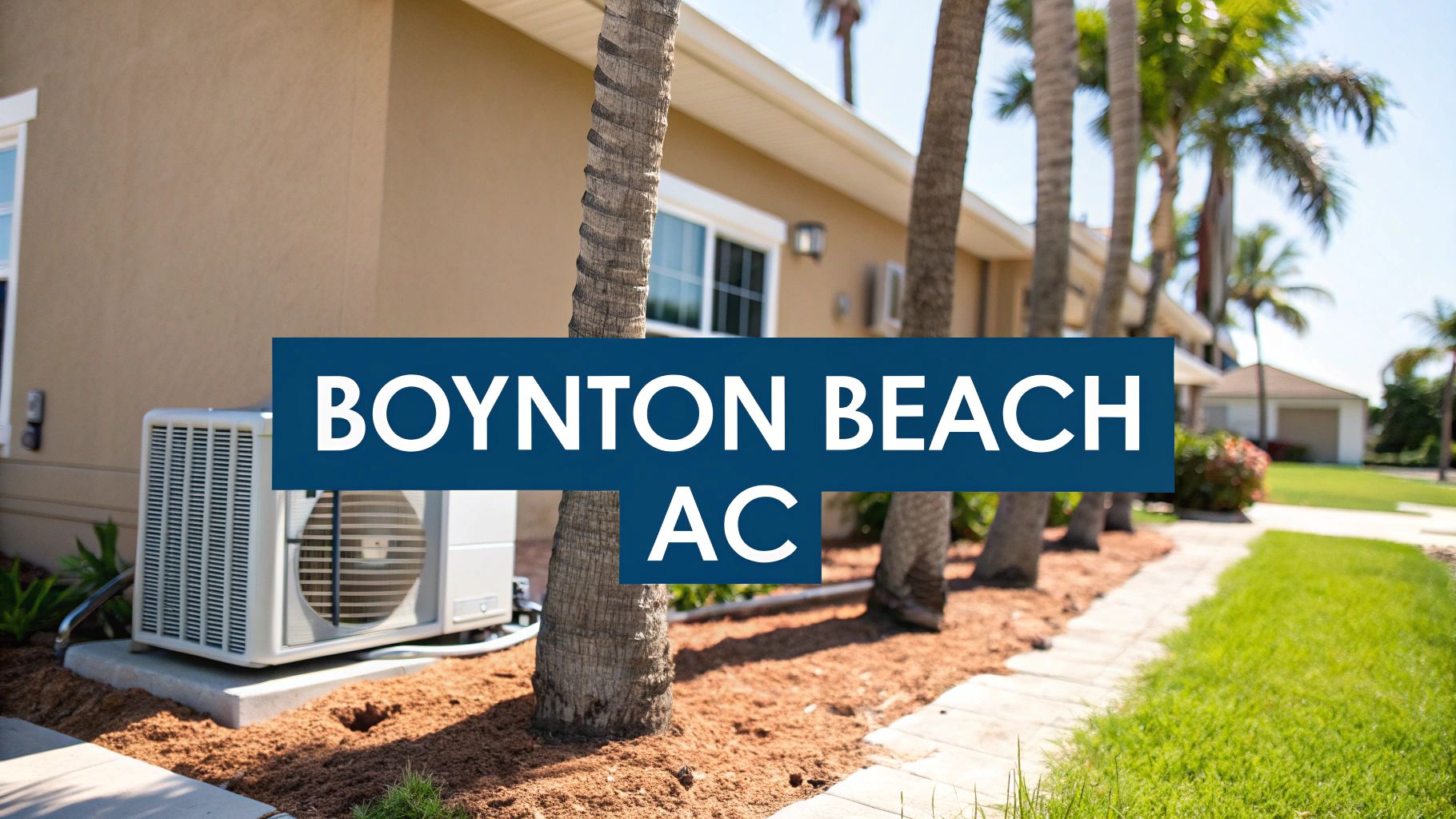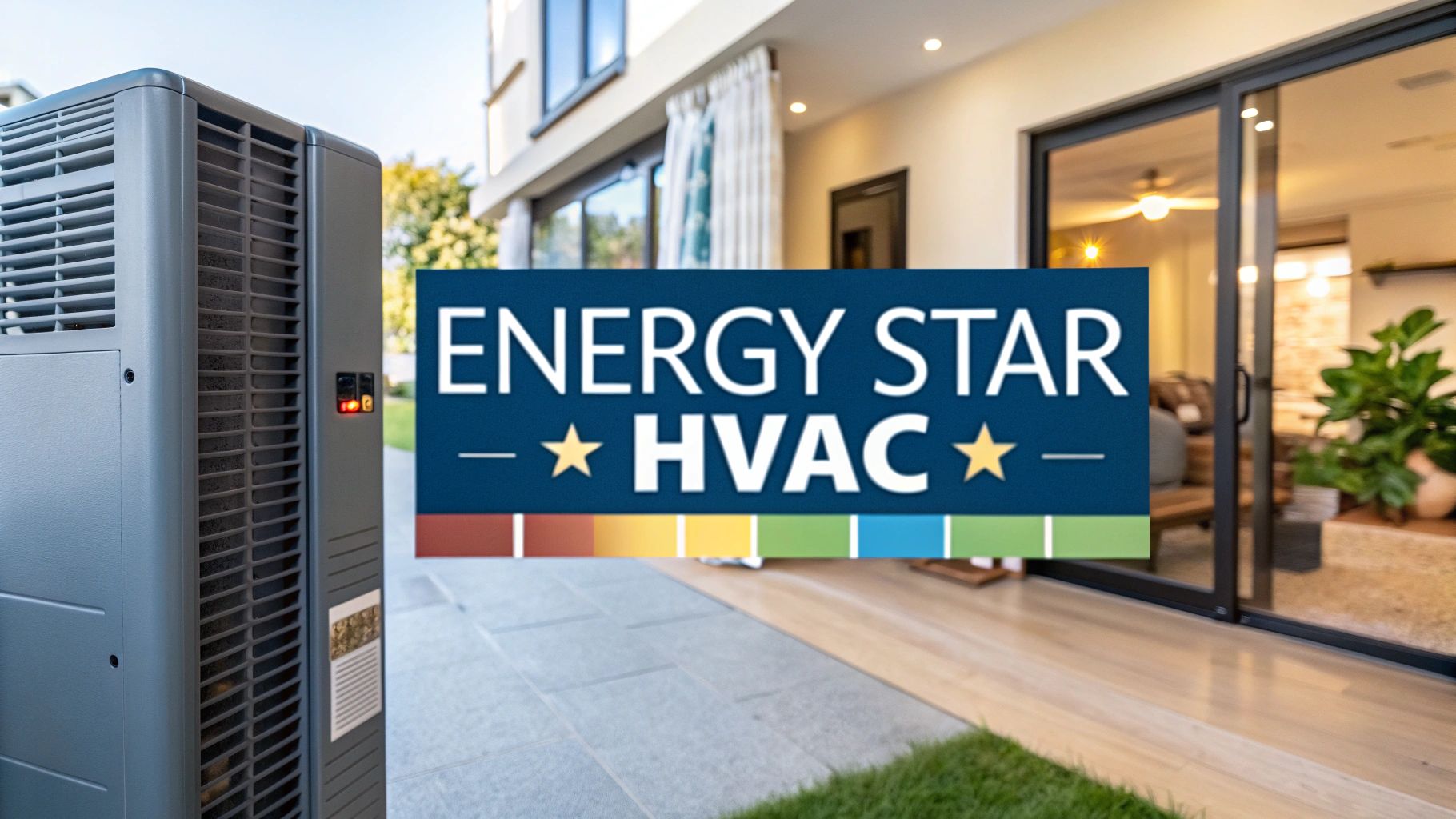Living in Palm Beach County means relying on your HVAC system to stay comfortable through the long, hot, and humid seasons. That constant cooling, however, comes at a cost, often making up the largest portion of your monthly utility bill. But what if you could maintain a cool and comfortable home without the shock of an expensive energy statement? The good news is, you can. Significant savings are not just possible; they are achievable with the right strategies and a little bit of know-how.
This guide is designed to provide you with practical and actionable hvac energy saving tips that go beyond the obvious advice to "just turn up the thermostat." We will explore a range of solutions, from simple maintenance tasks you can perform yourself to advanced technology upgrades that offer long-term returns. Each tip is broken down into simple, easy-to-understand steps, ensuring you have the information needed to make immediate changes. You will learn how to optimize your current system and what to look for when considering future upgrades like smart thermostats, zoned systems, or variable-speed equipment.
The goal is to empower you with knowledge, helping you cut down on energy waste and lower your cooling costs effectively. Before diving into specific HVAC upgrades, it's often beneficial to see the bigger picture of your home's energy usage. To truly understand your home's energy consumption and identify all areas for improvement, consider using a comprehensive home energy audit checklist. This will help pinpoint where you are losing the most energy, allowing you to make more targeted and impactful decisions. Let’s get started on the path to a more efficient and affordable home.
1. Harness the Power of Smart Thermostats for Automated Savings
Upgrading your thermostat is one of the most effective hvac energy saving tips you can implement, especially here in Palm Beach County where air conditioning is a near-constant necessity. A smart thermostat goes far beyond the basic functions of a manual or even a simple programmable model. It learns your household's patterns and automates your cooling schedule for maximum efficiency without sacrificing comfort.
Think of it as putting your AC on autopilot. Instead of you manually adjusting the temperature when you leave for work or go to sleep, a smart thermostat does it for you. This simple change prevents your system from needlessly cooling an empty house, which is a major source of energy waste.
How Smart Thermostats Drive Down Energy Bills
Smart thermostats use a combination of sensors, algorithms, and Wi-Fi connectivity to optimize your HVAC usage. They offer advanced features that directly translate into lower energy consumption and significant cost savings over time.
- Learning Capabilities: Models like the Nest Learning Thermostat or ecobee Smart Thermostat monitor your adjustments for the first week or so. They learn when you prefer it cooler (like overnight) and when the temperature can be set higher (like during the workday when no one is home).
- Geofencing: This feature uses your smartphone's location to determine if your home is occupied. As you leave the designated "home" area, the thermostat automatically adjusts to an energy-saving temperature. When you start heading back, it triggers the AC to cool your home to your preferred setting just before you arrive.
- Energy Reports: Most smart thermostats provide detailed reports accessible via an app. You can see exactly how many hours your HVAC system ran, identify patterns of high usage, and get personalized suggestions for even more savings.
Making a Smart Thermostat Work for You
Implementing this tip is straightforward. To get the most out of your upgrade, consider these actionable steps:
- Set an "Away" Temperature: Program your thermostat to set back the temperature by 7-10 degrees when you are not home. In our warm Florida climate, this means setting it to a higher temperature like 82°F instead of 75°F.
- Utilize Scheduling: Even if your routine is inconsistent, set a basic schedule. For example, program the temperature to rise a few degrees 30 minutes before you typically wake up and lower it again 30 minutes before you usually return home.
- Connect to Wi-Fi: Always connect your device to your home’s Wi-Fi. This is essential for remote control, receiving software updates, and accessing energy usage data, which are key to maximizing its benefits.
Key Insight: The U.S. Department of Energy estimates that you can save as much as 10% a year on heating and cooling by simply turning your thermostat back 7°-10°F for 8 hours a day from its normal setting. A smart thermostat automates this process, ensuring you never forget.
By automating your cooling schedule, a smart thermostat removes the guesswork and human error from managing your home’s climate. It’s a powerful tool that offers both convenience and substantial, consistent energy savings, making it a cornerstone of any modern, energy-efficient home in South Florida.
2. Prioritize Regular HVAC Filter Replacement for Peak Efficiency
Of all the hvac energy saving tips available, regularly changing your HVAC air filter is arguably the simplest and most cost-effective. A dirty, clogged filter forces your air conditioner to work significantly harder to pull air through, leading to increased energy consumption and unnecessary strain on vital components. This single piece of maintenance is fundamental to your system's health and your home's energy efficiency.
Think of it like trying to breathe through a thick cloth. The more clogged the filter gets with dust, pollen, and pet dander common in Palm Beach County, the more your HVAC system struggles. This struggle translates directly into higher electricity bills and can shorten the lifespan of your unit.
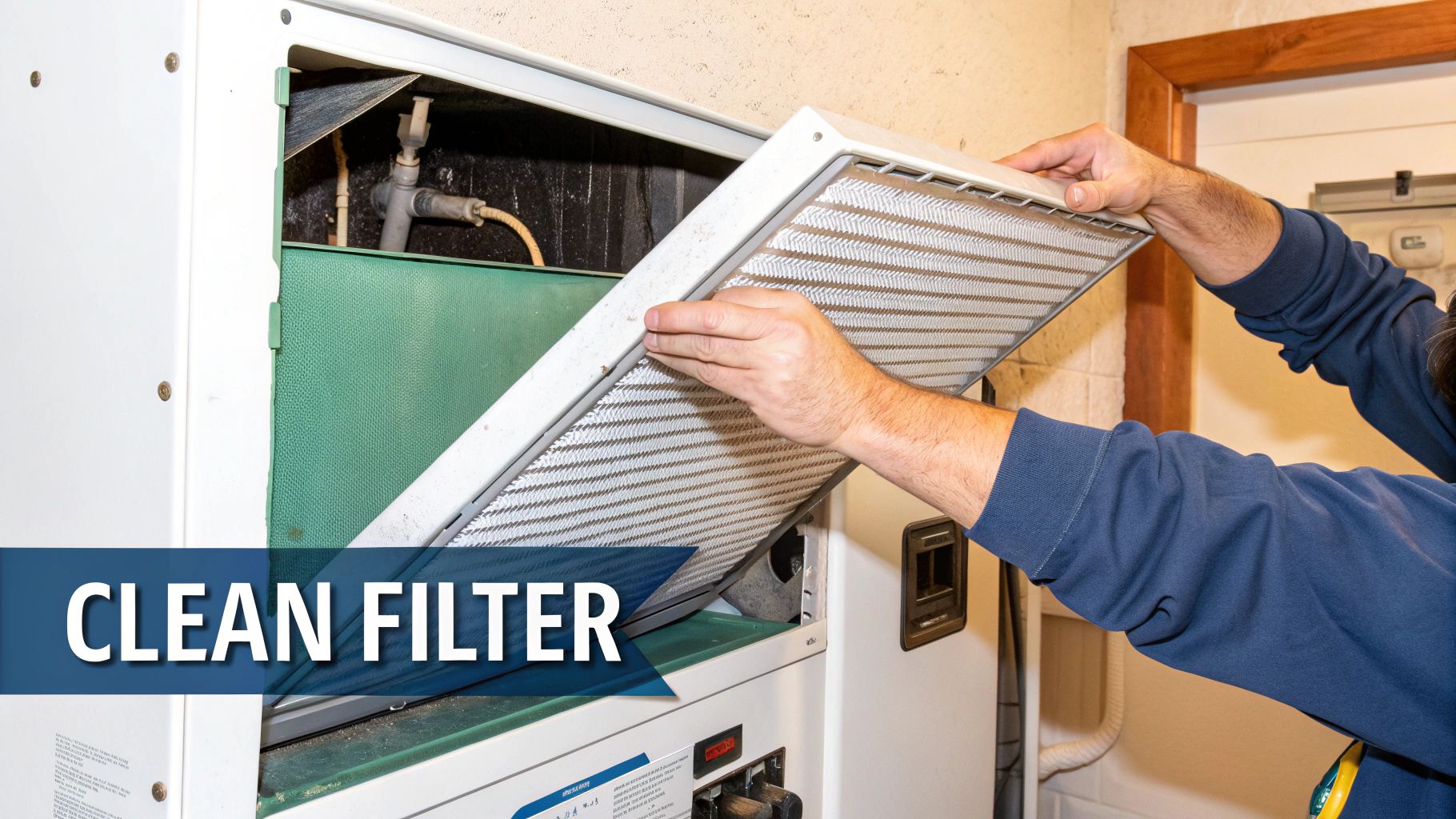
How Clean Filters Boost Efficiency and Savings
A clean air filter ensures that air can flow freely into your HVAC system. This unrestricted airflow allows the system to cool your home efficiently, using less energy to achieve and maintain your desired temperature. The benefits extend beyond just energy savings.
- Reduced System Strain: When airflow is optimal, components like the blower motor do not have to overwork. This reduces wear and tear, preventing premature breakdowns and costly repairs.
- Improved Indoor Air Quality: The filter's primary job is to trap airborne contaminants. A clean filter does this effectively, leading to healthier air inside your home, which is especially important for those with allergies or respiratory issues.
- Consistent Cooling Performance: A clogged filter can restrict airflow so much that some rooms may not cool as effectively as others. A clean filter helps ensure even and consistent temperature distribution throughout your home.
Making Filter Replacement a Simple Habit
Integrating this tip into your routine is easy and requires minimal effort. To maximize the benefits of a clean filter, follow these actionable steps:
- Check Monthly, Replace Quarterly: Make it a habit to visually inspect your filter every month. For most homes in our area, a replacement is needed every 1-3 months. If you have pets or allergies, stick to a monthly schedule.
- Use the Right Filter: Higher MERV ratings capture smaller particles but can also restrict airflow more. For most residential systems, a filter with a MERV rating between 8 and 11 offers a great balance of air filtration and efficiency. Unsure which one is right for you? Explore our guide to selecting the best filters for air vents in your home.
- Set Reminders: Use a calendar app on your phone or subscribe to an automatic filter delivery service like FilterBuy. Many homeowners also find it helpful to write the installation date directly on the filter's cardboard frame.
Key Insight: According to the U.S. Department of Energy, replacing a dirty, clogged filter with a clean one can lower your air conditioner's energy consumption by 5% to 15%. This simple task provides an immediate and noticeable return on a very small investment.
By making filter replacement a non-negotiable part of your home maintenance routine, you ensure your HVAC system operates at its best. It's a small action that delivers significant results in energy savings, system longevity, and indoor air quality for your South Florida home.
3. Proper Ductwork Sealing and Insulation
Your HVAC system is only as efficient as its delivery network. If your ductwork, which runs through unconditioned spaces like attics, crawl spaces, or walls, is leaky or poorly insulated, you could be losing a significant amount of the conditioned air you’re paying to cool. This is one of the most impactful hvac energy saving tips because it addresses the very foundation of your system's performance.
Think of it like trying to carry water in a bucket full of holes. Your AC unit works hard to produce cool air, but gaps, cracks, and disconnected joints in the ductwork allow that valuable air to escape before it ever reaches your living spaces. Sealing and insulating these pathways ensures the cool air gets where it's supposed to go efficiently.
How Leaky Ducts Inflate Your Energy Bills
Leaky ducts force your HVAC system to run longer and harder to achieve the temperature set on your thermostat, leading to higher energy consumption and increased wear and tear. According to the EPA's ENERGY STAR program, the typical home can lose 20% to 30% of the air that moves through the duct system due to leaks, holes, and poor connections.
- Wasted Conditioned Air: The primary issue is the direct loss of cooled air into unconditioned areas. This is a complete waste of energy and money, especially during the sweltering Palm Beach County summers.
- Poor Air Quality: Leaks can also pull in dusty, moldy, or polluted air from attics, crawl spaces, and wall cavities, distributing these contaminants throughout your home.
- Uneven Temperatures: If some rooms are consistently hotter or stuffier than others, leaky ducts are a likely culprit. The compromised airflow prevents consistent temperature distribution.
Making Duct Sealing and Insulation Work for You
Tackling your ductwork is a project that delivers substantial returns. The following infographic outlines the straightforward process professionals use to restore duct efficiency.
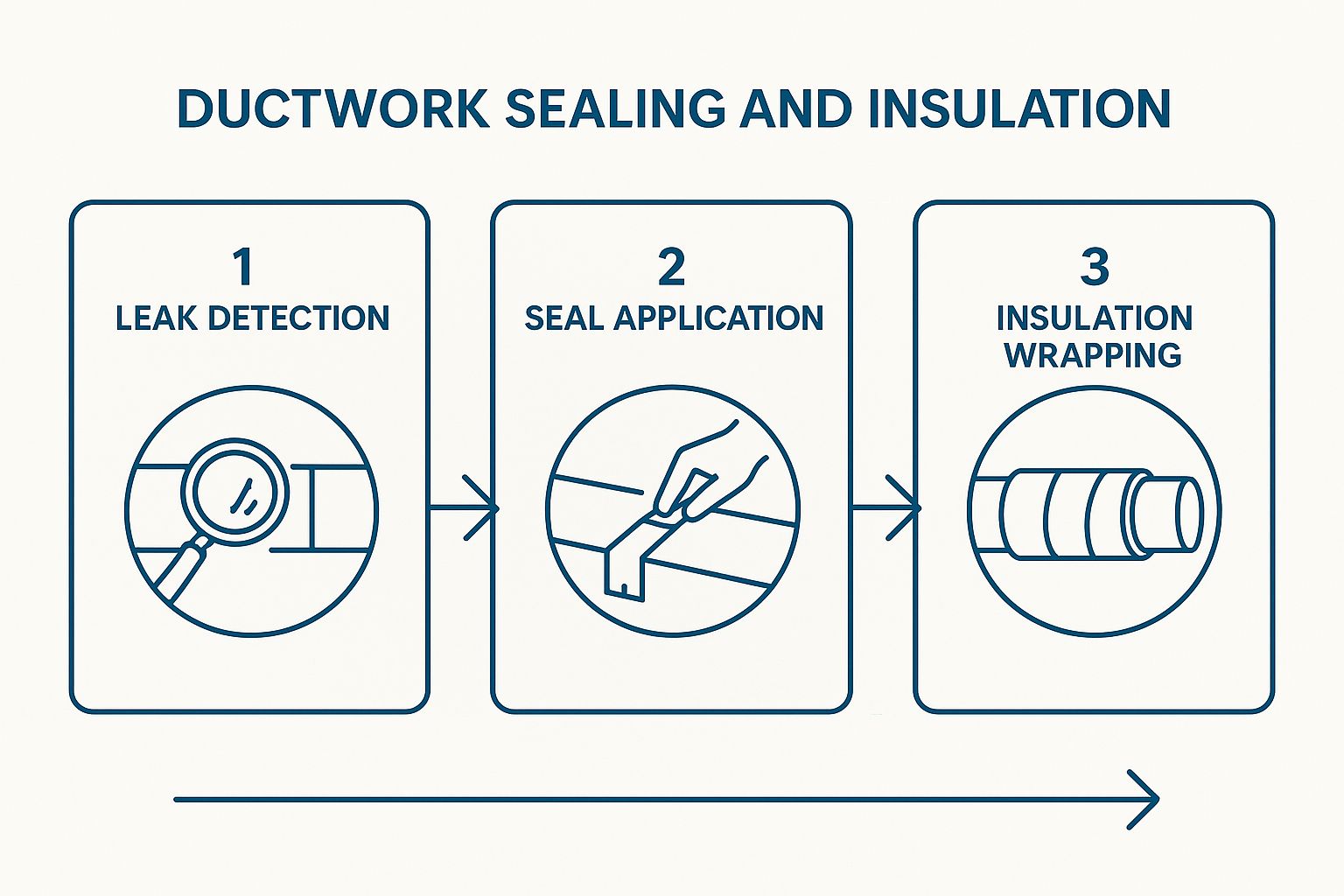
This visual guide breaks down the essential steps from finding the leaks to sealing and insulating them, forming a comprehensive approach to maximizing HVAC efficiency. To get started, consider these actionable steps:
- Prioritize Unconditioned Spaces: Focus your sealing efforts on ducts located in your attic, garage, or crawl space, as these areas experience the most extreme temperature differences and lead to the greatest energy loss.
- Use the Right Materials: For a durable, long-lasting seal, use mastic sealant or metal-backed foil tape. Standard cloth-backed duct tape is not suitable, as it degrades quickly from heat and humidity.
- Consider Professional Testing: A professional can perform a blower door test to pressurize your duct system, making it easy to identify the exact location and severity of every leak for targeted repairs.
- Insulate After Sealing: Once all leaks are sealed, wrap the ducts in unconditioned spaces with appropriate insulation (typically R-6 or R-8) to prevent heat transfer and keep the air inside them cool.
Key Insight: A study by Lawrence Berkeley National Laboratory found that sealing ductwork can reduce energy consumption for heating and cooling by an average of 18%. For many homeowners, this translates into hundreds of dollars in annual savings.
By ensuring your ductwork is properly sealed and insulated, you stop wasting energy and start enjoying better comfort, lower bills, and improved indoor air quality. It's a foundational step that enhances the effectiveness of all other HVAC efficiency measures.
4. Divide and Conquer with Zoned HVAC Systems
Implementing a zoned HVAC system is a transformative approach to home climate control and one of the most intelligent hvac energy saving tips for homeowners in Palm Beach County. Instead of cooling your entire house to a single temperature, a zoned system divides your home into distinct areas, or "zones," each controlled by its own thermostat. This allows you to cool only the rooms you are using, drastically reducing energy waste.
Think of it like the lighting in your home; you wouldn't turn on every single light just to read in the living room. A zoned system applies this same logic to your air conditioning, using motorized dampers within the ductwork to direct cool air precisely where it's needed and prevent it from going to empty spaces like guest rooms or formal dining areas.
How HVAC Zoning Slashes Energy Consumption
Zoned systems work by giving you granular control over your home's environment. This targeted approach prevents your AC from overworking to cool unoccupied areas, which is a common problem in larger or multi-story homes common in our South Florida communities. This precise control leads directly to lower utility bills.
- Targeted Cooling: A zoned system allows you to set different temperatures for different areas. For instance, you can keep the living areas at a comfortable 74°F during the day while allowing the upstairs bedrooms to stay warmer, then reverse that schedule at night.
- Accommodates Different Needs: It solves the common problem of one part of the house being too hot while another is too cold. Zones can be designed around areas with different sun exposure or usage patterns, ensuring consistent comfort everywhere.
- Reduced System Runtime: By not having to cool the entire square footage of your home all the time, your HVAC system runs for shorter periods. This not only saves energy but also reduces wear and tear on expensive components like the compressor and air handler.
Making a Zoned System Work for You
Proper design and implementation are key to maximizing the benefits of HVAC zoning. Follow these actionable steps to get started:
- Design Zones Logically: Group rooms with similar cooling needs and schedules. For example, create a zone for bedrooms, another for common living areas (kitchen, family room), and a third for rarely used spaces like a home office or guest suite.
- Ensure Proper Equipment Sizing: A zoned system changes the airflow dynamics of your home. It's crucial that your HVAC unit is correctly sized to handle the variable loads without short-cycling, which wastes energy.
- Program Your Zones: Use the multiple thermostats to create a schedule that reflects your family’s daily routine. Set temperatures in unused zones several degrees higher during work or school hours to maximize savings.
Key Insight: According to the U.S. Department of Energy, HVAC zoning can lead to energy savings of up to 30% when combined with a programmable thermostat setup. By cooling only occupied areas, you eliminate a significant portion of your home's energy waste.
A zoned system offers unparalleled control and efficiency, making it a powerful upgrade for any homeowner serious about reducing their energy consumption. It’s an investment that pays for itself through substantial, long-term savings. To understand if your home is a good candidate for zoning, a thorough evaluation is the first step. You can get a better idea of your home's specific needs by conducting an initial review; learn more about how to get started with a home energy audit checklist.
5. Embrace the Efficiency of Modern Heat Pump Technology
When considering long-term hvac energy saving tips, upgrading your entire system is often the most impactful decision you can make. For homeowners in Palm Beach County, modern heat pump technology offers a revolutionary way to handle both our intense cooling needs and our milder heating requirements with unparalleled efficiency. Unlike traditional furnaces that burn fuel, heat pumps work by transferring heat, which is a much more energy-conscious process.
In the summer, a heat pump functions exactly like a high-efficiency air conditioner, moving heat from inside your home to the outdoors. In the winter, it reverses the process, extracting ambient heat from the outside air and transferring it inside to warm your home. This dual functionality from a single unit is what makes it a smart investment.
How Heat Pump Upgrades Slash Your Energy Costs
Modern heat pumps, especially those from leading brands like Carrier, Trane, and Mitsubishi, have advanced significantly. They are far more efficient than older models and provide consistent comfort while using a fraction of the energy. Their savings potential comes from several key features.
- Exceptional Efficiency Ratings: New heat pumps can achieve a Seasonal Energy Efficiency Ratio (SEER) of 20 or higher for cooling and a Heating Seasonal Performance Factor (HSPF) of 10 or more. These high ratings directly correlate to lower electricity consumption for both cooling and heating.
- Variable-Speed Compressors: Instead of running at full blast and then shutting off, variable-speed technology allows the system to run almost continuously at lower, steadier speeds. This avoids the energy spikes of constant startups and provides more precise temperature and humidity control.
- Smart Controls Integration: Advanced heat pumps are designed to pair seamlessly with smart thermostats, further optimizing performance based on your home's unique needs and occupancy patterns.
Making a Heat Pump Upgrade Work for You
Switching to a modern heat pump is a major upgrade, and proper planning ensures you maximize your return on investment. If you're wondering when to replace your HVAC system, a high-efficiency heat pump should be at the top of your list.
- Choose an ENERGY STAR Certified Model: These units are independently verified to meet strict energy efficiency guidelines set by the U.S. Environmental Protection Agency, guaranteeing superior performance and savings.
- Insist on a Professional Load Calculation: Proper sizing is critical. A system that is too large or too small will struggle to operate efficiently. A professional "Manual J" load calculation ensures the unit is perfectly matched to your home's square footage, insulation, and window layout.
- Explore Federal Incentives: Take advantage of federal tax credits, which can cover up to 30% of the cost of a qualifying high-efficiency heat pump installation through 2032. This significantly reduces the upfront cost.
Key Insight: According to the U.S. Department of Energy, a modern, high-efficiency heat pump can reduce your electricity use for heating by approximately 50% compared to electric resistance heating such as furnaces and baseboard heaters.
By upgrading to an advanced heat pump, you are not just replacing old equipment; you are investing in a sophisticated, all-in-one climate solution. It’s one of the most powerful HVAC energy saving tips for Florida homeowners, delivering substantial cost reductions and superior year-round comfort.
6. Utilize Programmable and Smart Scheduling
Beyond basic automation, one of the most impactful hvac energy saving tips is to master programmable and smart scheduling. This strategy involves creating a detailed, dynamic schedule for your HVAC system that aligns perfectly with your household’s occupancy patterns, the time of day, and even seasonal changes. It moves beyond simple on/off commands to truly optimize when and how your system operates.
This advanced level of control ensures you are never conditioning an empty space, which is a primary driver of high energy bills in Palm Beach County. By telling your system exactly when you need it and when you don't, you eliminate energy waste and operate your HVAC with maximum intelligence.
How Advanced Scheduling Cuts Energy Costs
Programmable thermostats and smart scheduling systems use time-based commands to adjust your home's temperature automatically throughout the day and week. This prevents the system from running at full power during unoccupied periods, leading to significant reductions in energy consumption.
- Time-Based Adjustments: You can program your thermostat to raise the temperature (e.g., to 82°F) every weekday morning after you leave for work and then lower it back to a comfortable 75°F just before you return.
- Occupancy-Based Control: Modern systems can integrate with sensors or geofencing to detect when the house is empty and automatically enter an energy-saving mode, overriding the regular schedule for unexpected absences.
- Demand Response Integration: Some smart systems can connect with local utility programs. During peak demand periods, your utility can signal your thermostat to make a slight, temporary temperature adjustment, reducing strain on the grid and often earning you a credit on your bill.
Making a Programmable Schedule Work for You
Properly programming your thermostat is key to unlocking its full savings potential. Follow these steps to create an effective schedule:
- Set Unoccupied Temperatures: For any period of 8 hours or more when the house is empty (like work or school hours), program the thermostat 7-10 degrees higher than your usual setting.
- Use Gradual Adjustments: Instead of a sudden temperature drop right at your arrival time, program the system to start cooling 30-60 minutes beforehand. This gradual change is more efficient than forcing the system to cool the house rapidly.
- Create Seasonal Schedules: Your "away" schedule in the milder spring might be different from your schedule during the peak heat of August. Adjust your programming twice a year to account for changing daylight hours and outdoor temperatures.
- Leverage "Vacation Mode": When leaving for an extended period, use the vacation or hold feature. This allows you to set a single, consistent, energy-saving temperature (like 85°F) that overrides all regular programming until you return.
Key Insight: A family with a regular work and school schedule can save up to $300 annually just by implementing a consistent, programmed thermostat schedule. The savings come from systematically reducing HVAC runtime during predictable, unoccupied hours every single day.
By treating your thermostat's schedule as a dynamic tool rather than a "set it and forget it" feature, you can exert precise control over your energy usage. This proactive management is a cornerstone of an efficient home, delivering consistent savings while ensuring comfort is always there when you need it.
7. Upgrade to High-Efficiency Variable-Speed HVAC Equipment
For homeowners in Palm Beach County seeking the pinnacle of climate control and energy efficiency, upgrading to a variable-speed HVAC system is a transformative step. Unlike traditional single-stage units that are either fully on or completely off, variable-speed technology allows your system to operate like a dimmer switch, precisely adjusting its output to meet your home's exact cooling needs at any given moment.
This sophisticated approach to cooling is one of the most impactful hvac energy saving tips for long-term savings. By running at lower, more consistent speeds for longer periods, these systems avoid the energy-intensive cycles of constantly shutting down and restarting, which is typical for older, single-speed models.
How Variable-Speed Systems Maximize Efficiency
Variable-speed equipment utilizes advanced motors and compressors that can operate across a wide range of capacities, often from as low as 25% up to 100%. This modulation offers superior performance and comfort, directly translating into significant energy reductions.
- Precise Temperature Control: These systems make micro-adjustments to their speed to maintain your desired temperature with extreme accuracy, often within half a degree. This eliminates the uncomfortable temperature swings common with traditional units.
- Superior Dehumidification: Because the system runs for longer cycles at a lower speed, it has more time to pull moisture out of the humid Florida air. This results in a much more comfortable indoor environment, often allowing you to set the thermostat a few degrees higher.
- Drastically Reduced Energy Use: According to ENERGY STAR, homeowners can see energy savings of 20-30% by upgrading to certified variable-speed equipment. For example, a home in Texas achieved a 25% reduction in cooling costs after installing a variable-speed air conditioner.
Making a Variable-Speed System Work for You
Investing in advanced equipment like a Carrier Infinity or Trane XV series system requires a strategic approach to maximize its benefits. Follow these actionable steps for a successful upgrade:
- Demand a Professional Load Calculation: Proper system sizing is critical. An undersized unit will struggle, while an oversized unit will short-cycle, negating the efficiency benefits. Insist on a Manual J load calculation from your HVAC contractor.
- Embrace Longer Run Times: Don't be alarmed if your new system runs for much longer periods than your old one. This is by design. Longer, slower cycles are where the system achieves its peak efficiency and provides the best dehumidification.
- Pair with a Smart Thermostat: To unlock the full potential of a variable-speed system, pair it with its corresponding communicating smart thermostat. This allows the components to "talk" to each other and make real-time adjustments for optimal performance.
Key Insight: The primary benefit of variable-speed technology is its ability to almost perfectly match its energy consumption to your home's cooling demand. Instead of using 100% power to handle a 40% cooling load, it can ramp down to use just 40% power, drastically cutting waste.
By continuously adapting to changing conditions, a variable-speed HVAC system provides unparalleled comfort and the highest level of energy efficiency available today. It’s an investment that pays dividends in both lower utility bills and a superior indoor climate, making it an essential consideration for any South Florida homeowner.
7 HVAC Energy Saving Tips Comparison
| Item | Implementation Complexity 🔄 | Resource Requirements ⚡ | Expected Outcomes 📊 | Ideal Use Cases 💡 | Key Advantages ⭐ |
|---|---|---|---|---|---|
| Smart Thermostats | Medium – Requires Wi-Fi & possible pro install | Moderate – Device cost $100-$300, Wi-Fi needed | 10-15% energy savings on heating/cooling | Homes seeking automated climate control & remote management | Precise control, energy reports, remote access |
| Regular HVAC Filter Replacement | Low – Routine manual replacement | Low – Filters cost $5-$30, frequent monitoring | 5-15% HVAC efficiency improvement | All HVAC systems needing maintenance & indoor air quality | Low cost, improves system lifespan, better air quality |
| Proper Ductwork Sealing and Insulation | High – Professional testing & sealing needed | High – Cost $1,500-$4,000, specialized materials | 20-40% reduction in heating/cooling energy use | Homes with leaky ducts or poorly insulated ductwork | Large energy savings, enhanced comfort, rebate eligible |
| Zoned HVAC Systems | High – Complex installation & system design | High – $2,500-$7,500 retrofit cost | 20-30% energy cost reduction | Larger/multi-story homes with varied occupancy | Customized comfort, reduces energy waste in unused zones |
| Heat Pump Technology Upgrades | High – Equipment replace plus possible electrical upgrades | Very High – $4,000-$20,000 plus installation | 30-60% heating cost reduction, 20-40% cooling savings | Cold climates, homes needing efficient heating & cooling | Dual function, eco-friendly, tax credits available |
| Programmable and Smart Scheduling | Medium – Setup & programming required | Low to Moderate – Often software or thermostat based | 10-20% heating/cooling cost savings | Homes or buildings with predictable occupancy patterns | Automated schedules, utility integration, peak demand reduction |
| Variable Speed HVAC Equipment | High – Advanced system requiring professional install | High – $1,000-$3,000 premium cost | 20-30% better efficiency than single-speed systems | Homes needing precise climate & humidity control | Energy efficient, quieter operation, longer lifespan |
Your Next Step Toward a More Comfortable and Cost-Effective Home
You've just navigated a comprehensive list of powerful HVAC energy saving tips, each designed to transform your Palm Beach County home from an energy consumer into an efficiency champion. We've moved beyond the basics, exploring how strategic upgrades and smart habits can lead to significant savings and enhanced comfort, even during Florida's most demanding heatwaves.
Let's quickly recap the core strategies we've discussed. We started with the foundational importance of smart thermostats and the simple yet impactful habit of regular filter replacements. From there, we delved into the structural integrity of your system, highlighting how sealed and insulated ductwork prevents costly energy loss. We also explored advanced solutions like zoned HVAC systems for customized comfort, the incredible efficiency of modern heat pump technology, and the precision control offered by variable speed equipment.
Turning Knowledge into Actionable Savings
The true value of these tips lies not just in understanding them, but in implementing them. The journey to a more energy-efficient home isn't about making one massive change overnight. Instead, it’s about layering small, consistent actions and strategic investments over time.
Think of it as building an "efficiency portfolio" for your home. Each tip you implement adds another layer of savings and resilience.
- Low-Hanging Fruit: Start with the simplest changes. If you haven't already, check your air filter this weekend. It's a five-minute task that can immediately improve airflow and reduce strain on your system.
- Behavioral Shifts: Take a closer look at your thermostat schedule. Are you cooling an empty house? Adjusting your settings by even a few degrees when you're away or asleep is a powerful, cost-free habit.
- Long-Term Planning: Use this guide as a roadmap for future upgrades. When your current system nears the end of its lifespan, you’ll be prepared to ask informed questions about variable speed technology or the benefits of a heat pump.
Key Takeaway: True HVAC efficiency is a blend of technology, maintenance, and mindful usage. By combining smart equipment with consistent care, you create a system that works for you, not against your budget.
The Broader Impact: More Than Just Money
Mastering these HVAC energy saving tips delivers benefits that extend far beyond your monthly utility bill. A well-maintained, efficient system provides more consistent temperatures throughout your home, eliminating those frustrating hot and cold spots. It also improves indoor air quality by filtering out dust, allergens, and other pollutants more effectively. This creates a healthier and more comfortable living environment for you and your family.
Furthermore, reducing your home's energy consumption contributes to a larger goal of energy conservation within our community. As our region continues to grow, mindful energy use becomes increasingly important. To further enhance your home's efficiency and cost-effectiveness, especially in Florida, many homeowners are also exploring solar energy solutions for Florida homes. Pairing an efficient HVAC system with renewable energy can dramatically lower your carbon footprint and your reliance on the grid.
Your home is likely your most significant investment, and your HVAC system is its heart, tirelessly working to keep you comfortable. By taking these proactive steps, you are not just cutting costs; you are actively protecting that investment, enhancing your quality of life, and making a smart, forward-thinking choice. The path to a cooler, more affordable home is clear, and the first step is yours to take.
Ready to put these HVAC energy saving tips into action with professional guidance? The experts at Florida Cooling Group are here to help Palm Beach County residents optimize their systems for peak performance and efficiency. Whether you need a system tune-up, a ductwork inspection, or advice on the latest high-efficiency equipment, contact Florida Cooling Group to schedule your consultation today.
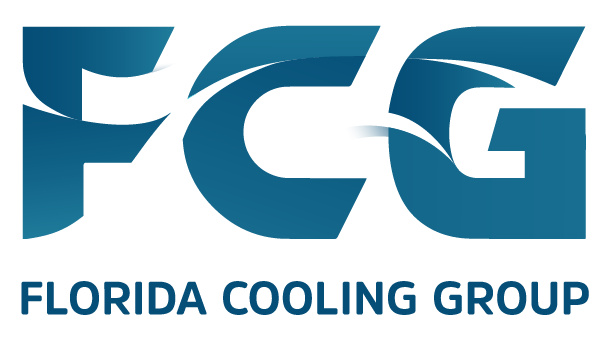
 (561) 400-2205
(561) 400-2205